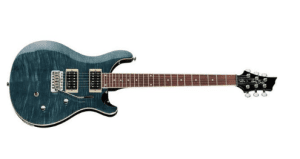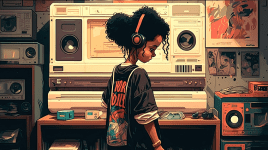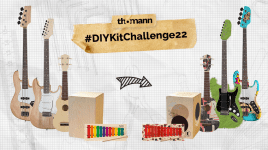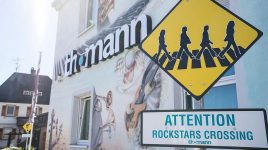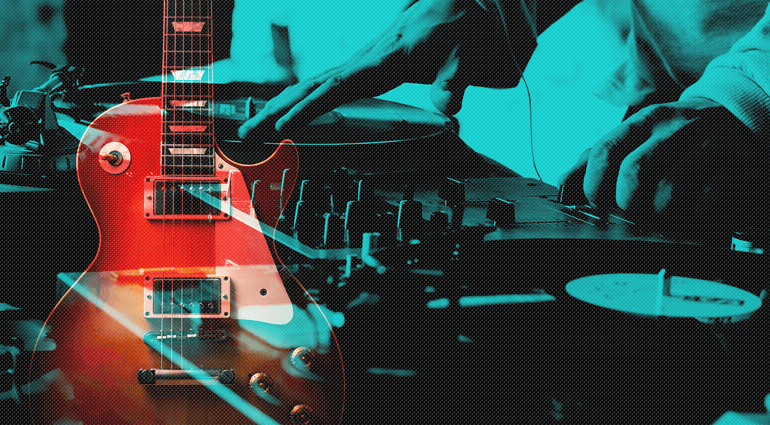
The electric guitar plays a larger role in hip-hop music than you might expect. In fact, the electric guitar has appeared again and again as a style-defining element throughout the entire history of hip-hop. Don’t believe us? Find out more in this article.🎸😎
A Brief History of Hip-hop
The origins of hip-hop music can be traced back to the African-American neighbourhoods of the Bronx (New York City) in the mid-1970s. Hip-hop is historically inseparable from the DJing, breakdance, and graffiti cultures. It came about more or less by accident when loop-based music was fused with chanting (rap) at the block parties of that time. DJs realised that dancers loved it when they isolated and looped drum breaks from funk and soul. Consequently, they played certain sections of two identical records over and over again (“beatjuggling”) – the first primitive live looping and sampling techniques were born.
Sie sehen gerade einen Platzhalterinhalt von Standard. Um auf den eigentlichen Inhalt zuzugreifen, klicken Sie auf den Button unten. Bitte beachten Sie, dass dabei Daten an Drittanbieter weitergegeben werden.
Rapping is also said to have originated at these block parties. The hosts of the party – known as “masters of ceremony” (M.C. for short) – began to fire up the crowd with short rhymes over the microphone and continued to refine this technique until it became a discipline in its own right in hip-hop.
Sie sehen gerade einen Platzhalterinhalt von Standard. Um auf den eigentlichen Inhalt zuzugreifen, klicken Sie auf den Button unten. Bitte beachten Sie, dass dabei Daten an Drittanbieter weitergegeben werden.
While most early hip-hop tracks were still based on live instrumentals, synthesizers, and drum machines, the late 1980s marked an important turning point in hip-hop history. With the introduction of compact samplers and sequencers such as the E-MU SP-1200 (1987) and the Akai MPC60 (1988), it was now possible to record short samples from other sources such as records, adjust their pitch and speed, and turn them into loops together with a drum pattern. The sound aesthetics associated with this workflow became a fundamental element of hip-hop and paved the way for some legendary productions that used samples from every conceivable musical genre. This way, the (distorted) electric guitar also found its way into hip-hop.
You are currently viewing a placeholder content from YouTube. To access the actual content, click the button below. Please note that doing so will share data with third-party providers.
The Electric Guitar in Hip-hop
As you can imagine, the electric guitar played a somewhat less central role in hip-hop than perhaps the electric bass, drums, or synthesizer. However, as the first hip-hop productions were still largely recorded instrumentally, the electric guitar appears often, sometimes even as a style-defining element. A very early example is the song “The Breaks” by Kurtis Blow, which features a funky guitar lick in a prominent role.
You are currently viewing a placeholder content from YouTube. To access the actual content, click the button below. Please note that doing so will share data with third-party providers.
One of the first and most memorable appearances of a distorted electric guitar in a hip-hop track came from Joe Perry in the smash hit “Walk This Way” by Run DMC and Aerosmith from 1986. Contrary to popular belief, this is not a remix of the guitar tracks from the 1975 original, but a newly recorded interpretation under the direction of producer legend Rick Rubin.
You are currently viewing a placeholder content from YouTube. To access the actual content, click the button below. Please note that doing so will share data with third-party providers.
The same year, the same Mr Rubin produced a second famous hip-hop track with electric guitar, to be released in 1987: “No Sleep Till Brooklyn” by the Beastie Boys. None other than Kerry King from Slayer was enlisted to blow off steam on the electric guitar in two solo passages.
You are currently viewing a placeholder content from YouTube. To access the actual content, click the button below. Please note that doing so will share data with third-party providers.
The third hip-hop classic that relies heavily on the electric guitar is “Bring The Noise” by Anthrax and Public Enemy. Having originally released the track as a hip-hop record in 1988, Public Enemy teamed up with thrash metal pioneers Anthrax three years later to reinterpret it. From today’s perspective, “Bring The Noise” laid the groundwork for countless rap-metal acts of the 90s and 2000s such as Body Count, Rage Against The Machine and Limp Bizkit. The soundtrack to the 1993 film “Judgement Night” was equally groundbreaking, as it consisted entirely of collaborations between rock/metal and hip-hop acts.
You are currently viewing a placeholder content from YouTube. To access the actual content, click the button below. Please note that doing so will share data with third-party providers.
While the 90s saw a wave of crossover acts that explored the ground between rap and metal, the electric guitar was used less frequently by pure hip-hop artists. West Coast gangsta rap in particular favoured “smooth” productions and synthesizer-based arrangements, which didn’t go well with the raw tones of a (distorted) electric guitar. However, there were exceptions: In New York, P. Diddy (formerly Puff Daddy) based three of his biggest hits on famous electric guitar samples: “I’ll Be Missing You” from 1997 (The Police – Every Breath You Take), “Come With Me” from 1998 (Led Zeppelin – Kashmir) and “Bad Boy For Life” from 2001 (Labi Siffre – I got the…).
You are currently viewing a placeholder content from YouTube. To access the actual content, click the button below. Please note that doing so will share data with third-party providers.
Eminem’s timeless classic “Lose Youself” from the soundtrack to the film “8 Mile” also begins with a characteristic electric guitar sample in D minor that’s sure to stick in the head of anyone who has ever heard this song.
You are currently viewing a placeholder content from YouTube. To access the actual content, click the button below. Please note that doing so will share data with third-party providers.
Even if it is strictly speaking an acoustic guitar, the 1993 song “Shape Of My Heart” by Sting (guitar played by Dominic Miller) deserves a mention here. First reinterpreted in 1996 (Nas with “The Message”), the first 11 seconds of this song became one of the most frequently sampled guitar loops ever and only recently made the top 10 again in the song “Lucid Dreams” by Juice WRLD.
You are currently viewing a placeholder content from YouTube. To access the actual content, click the button below. Please note that doing so will share data with third-party providers.
If you take a closer look, it’s hard to imagine hip-hop without the electric guitar. Be it through the many collaborations of the 80s and 90s, which led to the development of styles like crossover or rap-metal, or the countless guitar samples in legendary hip-hop productions. And if you’re looking for a current example of an electric guitar catapulting a rap act into new spheres, we recommend the intro to Stormzy’s performance at Reading Festival 2021 together with YouTube star and guitar influencer Rabea Massaad.
You are currently viewing a placeholder content from YouTube. To access the actual content, click the button below. Please note that doing so will share data with third-party providers.
Feedback: Electric Guitar in Hip-hop songs
Can you think of more hip-hop tracks that feature an electric guitar? Let us know in the comments.
You are currently viewing a placeholder content from Facebook. To access the actual content, click the button below. Please note that doing so will share data with third-party providers.
More InformationYou are currently viewing a placeholder content from Instagram. To access the actual content, click the button below. Please note that doing so will share data with third-party providers.
More InformationYou are currently viewing a placeholder content from X. To access the actual content, click the button below. Please note that doing so will share data with third-party providers.
More Information